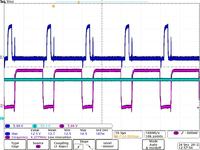sabu31
Advanced Member level 1
Hi
I am getting glitches in the gate of the H-Bridge inverter, the glitch magnitude increases with dc link voltage upto a limit of 6-7 volts.

Similar glitch is observerd at the optocoupler(6n137) ouput which goes to the driver (IR2110 ) which drives the inverter. How do we avoid this glitch.
Thanking you.
I am getting glitches in the gate of the H-Bridge inverter, the glitch magnitude increases with dc link voltage upto a limit of 6-7 volts.

Similar glitch is observerd at the optocoupler(6n137) ouput which goes to the driver (IR2110 ) which drives the inverter. How do we avoid this glitch.
Thanking you.